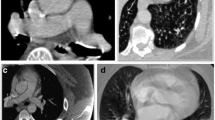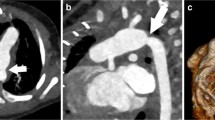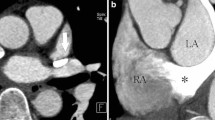Abstract
The Fontan procedure is the final stage in the palliative surgical approach to patients with single-ventricle physiology. These patients have an increased risk for thromboembolic disease in the Fontan circuit, which can be evaluated by chest computed tomography angiography (CTA) in acute settings. However, false-positive results are common secondary to unusual streaming patterns in the Fontan circuit. A biphasic CTA protocol was evaluated for the capability to clearly identify structures of the Fontan circuit that are critical for the evaluation of thromboembolic disease. The study was a retrospective chart review of Fontan patients with a chest CTA scan obtained between 2011 and 2017. Two pediatric cardiologists with additional training in cardiac CT imaging independently reviewed each CTA and awarded one point for each of 5 Fontan circuit structures clearly identified resulting in a score range of 0–5. A score of 0–2 considered not capable, 3–4 partially capable, and 5 capable to clearly identify critical structures of the Fontan circuit. During the study period, 46 CTA scans were performed on 21 patients. Of the CTA scans using a biphasic protocol, 62.5% (10/16) were considered capable to clearly identify all 5 critical structures of the Fontan circuit vs 27% (8/30) of the CTA scans using a monophasic protocol (p = 0.027). Overall our results suggest that the single-site biphasic CTA protocol has greater diagnostic capability to detect the presence of Fontan thromboembolic disease when compared to the more traditional monophasic CTA protocol. Future prospective studies are needed to confirm these findings.

Similar content being viewed by others
References
Fontan F, Baudet E (1971) Surgical repair of tricuspid atresia. Thorax 26(3):240–248
Puga FJ, Chiavarelli M, Hagler DJ (1987) Modifications of the Fontan operation applicable to patients with left atrioventricular valve atresia or single atrioventricular valve. Circulation 76(3):53–60
DeLeval MR, Kilner P, Gewillig M, Bull C (1988) Total cavopulmonary connection: a logical alternative to atriopulmonary connections for complex Fontan operations. J Thorac Cardiovasc Surg 96:682–695
Jonas RA, Castaneda AR (1988) Modified Fontan procedure: atrial baffle and systemic venous to pulmonary artery anastomotic techniques. J Card Surg 3(2):91–96
Laschinger JC, Ringel RE, Brenner JI, McLaughlin JS (1992) Extracardiac total cavopulmonary connection. Ann Thorac Surg 54(2):371–373
de Leval MR, Dubini G, Migliavacca F (1996) Use of computational fluid dynamics in the design of surgical procedures: application to the study of competitive flows in cavo-pulmonary connections. J Thorac Cardiovasc Surg 111:502–513
DeGroff CG (2008) Modeling the Fontan circulation: where we are and where we need to go. Pediatr Cardiol 29:3–12
Coon PD, Rychik J, Novello RT, Ro PS, Gaynor JW, Spray TL (2001) Thrombus formation after the Fontan operation. Ann Thorac Surg 71(6):1990–1994
Jacobs ML (2005) The Fontan operation, thromboembolism, and anticoagulation: a reappraisal of the single bullet theory. J Thorac Cardiovasc Surg 129(3):491–495
Allen K, Downing TE, Glatz AC, Rogers LS, Ravishankar C, Rychik J, Fuller S, Montenegro LM, Steven JM, Spray TL, Nicolson SC, Gaynor JW, Goldberg DJ (2017) Effect of Fontan-associated morbidities on survival with intact Fontan circulation. Am J Cardiol 119(11):1866–1871
Khairy P, Fernandes SM, Mayer JE Jr, Triedman JK, Walsh EP, Lock JE, Landzberg MJ (2008) Long-term survival, modes of death, and predictors of mortality in patients with Fontan surgery. Circulation 117(1):85–92
Alsaied T, Bokma JP, Engel ME, Kuijpers JM, Hanke SP, Zuhlke L, Zhang B, Veldtman GR (2017) Factors associated with long-term mortality after Fontan procedures: a systematic review. Heart 103(2):104–110
Goldberg DJ, Dodds K, Rychlik J (2010) Rare problems associated with the Fontan circulation. Cardiol Young 20(3):113–119
Tomkiewicz-Pajak L, Hoffman P, Trojnarska O, Lipczyńska M, Podolec P, Undas A (2014) Abnormalities in blood coagulation, fibrinolysis, and platelet activation in adult patients after the Fontan procedure. J Thorac Cardiovasc Surg 147:1284–1290
Sandler KL, Markham LW, Mah ML, Byrum EP, Williams JR (2014) Optimizing CT angiography in patients with Fontan physiology: single-center experience of dual-site power injection. Clin Radiol 69(12):562–567
Mahani M, Agarwal P, Rigsby C, Lu J, Dehkordy S, Wright R, Dorfman A, Krishnamurthy R (2016) CT for assessment of thrombosis and pulmonary embolism in multiple stages of single-ventricle palliation: challenges and suggested protocols. Radiographics 36(5):1273–1284
Funding
There are no industry relationships. There were no funding sources for the study.
Author information
Authors and Affiliations
Contributions
RB: Contributed to the development of the design of the study, participated in the chart review, data analysis, data interpretation, and statistical analysis, drafted the original manuscript, and participated in the revision process. TB: Contributed to the development of the design of the study, participated in the chart review, data analysis, data interpretation, and statistical analysis, and participated in the revision process. JC-V: Contributed to the development of the design of the study, participated in the chart review, data analysis, data interpretation, and statistical analysis, and participated in the revision process. CD: Contributed to data analysis, data interpretation, and statistical analysis, and participated in the revision process. NQ: Contributed to the development of the design of the study and critical revision of the manuscript. AC: Contributed to the development of the design of the study, participated in the chart review, data analysis, data interpretation, and statistical analysis, and critical revision of the manuscript.
Corresponding author
Ethics declarations
Conflict of interest
All authors declare that they have no conflict of interest.
Ethical Approval
This article does not contain any studies with human participants or animals performed by any of the authors.
Additional information
Publisher's Note
Springer Nature remains neutral with regard to jurisdictional claims in published maps and institutional affiliations.
Rights and permissions
About this article
Cite this article
Boggs, R., Dibert, T., Co-Vu, J. et al. Optimized Computed Tomography Angiography Protocol for the Evaluation of Thrombus in Patients with Fontan Anatomy. Pediatr Cardiol 41, 1601–1607 (2020). https://doi.org/10.1007/s00246-020-02417-9
Received:
Accepted:
Published:
Issue Date:
DOI: https://doi.org/10.1007/s00246-020-02417-9




